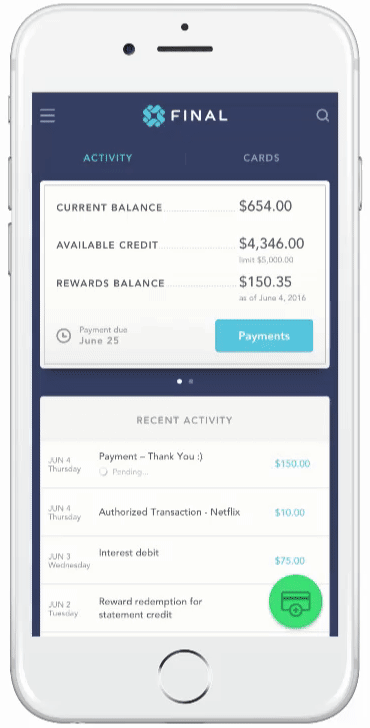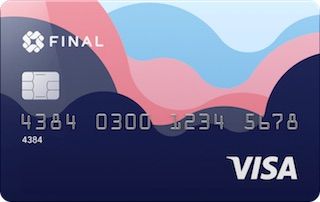Buying new furniture, appliances, or a mattress can be...
Final Card: Trying to Build a Credit Card Company Without Perverse Incentives

Ever had your credit card information stolen? Perhaps you used a card to buy gas or groceries, and the next thing you know there are odd purchases showing up in your account. While the Fair Credit Billing Act limits your loss from unauthorized purchases to $50, and many major credit card issuers have a zero-liability policy, dealing with a compromised, lost, stolen, or deactivated card can be frustrating.
Often you’ll need to cancel your card and order a new one. But what if you’re traveling and need a credit card to put on file at a hotel or rental car agency. Or, you’re overseas and don’t have easy access to your bank accounts. Plus, when the new card arrives you’ll have to update all your subscriptions, bill pays, and account profiles with the card’s information.
First-hand experience with these frustrations led Aaron Frank, Matt Rothstein, and Andrew Dietrich to start Final. In addition to offering a physical credit card, customers can generate multiple credit card numbers to use while shopping online.
Final launched with a pilot program in 2015 and started onboarding new customers in 2016. We spoke with Aaron Frank, CEO of Final, about how the service works, what it takes to get a Final account, and the future of the company. The following is an edited version of our conversation.

How does Final work to protect cardholders against fraud?
We give the users the ability to generate as many credit card numbers as they want, and the typical use case is one per merchant or one per transaction. It’s turning the phone or your web browser into an e-wallet and you’re able to pull a new card out with two clicks.
We’re a digital payments company powered by a credit line – it’s for anyone who shops digitally.
You’re now segmenting every relationship, so you’re able to control how these people charge you. We’re on the back end, working on your behalf to say only Uber is able to charge this “card,” because it’s your Uber card. If someone tries to use that card number at a different store, the transaction gets blocked and you’ll receive a notification. You could also create a one-time-use number that’s disabled after you complete a purchase.
In parallel to that, we give you a physical chip and signature card.
How can you generate so many card numbers?
We generate the numbers and we own the processing steps. They’re not actually virtual cards, they’re full primary account numbers (PANs) that just aren’t embossed on a card. It’s similar to how you’d add an authorized user or replace a lost card for your account
There are 100 million viable PANs on top of one bank identification number (BIN), the first four to six digits of a credit card number. Our models show we won’t run out of numbers any time soon.

What types of responses do you get from Final cardholders? What do they like, and what changes are they requesting?
From a user’s perspective we’re seeing people use the card within the first 24 hours of getting access to their line of credit. That’s something you often can’t do with a traditional credit card, because you don’t get access to your PAN that quick.
We launched with as much as we could bear from a resource prospective, and now we’re able to focus on building for the future. There’s some low-hanging fruit that we want to give people access to, like mobile payments. There’re also features like browser extensions and integration with personal finance management software that we’d like to offer.
There’s currently a wait list to apply for a Final account, how long is the wait?
As you bring a new product online, you want to make sure you understand the onboarding funnel and flows.
We’re focusing on optimizing the experience and understanding our customers before opening the floodgates.
We’re a startup so one of our problems is capital constraints. We look a bit like an alternative lender that needs to borrow money to lend it out to users. Even if you paid me back every month, I still have to lend you money.
That being said, adoption has been great and we’re onboarding more and more people every day. People who have cards are Tweeting about it telling their friends and the list is growing every day. The waitlist is right around 140,000 right now. It could take a few months to get through the list, but I can’t say for certain. One thing I can say is when an existing customers reaches out and refers a friend we can occasionally give the new person an invite code. Keep in mind the invite doesn’t guarantee you’ll be approved.
What credit score will someone need to get approved for a Final account?
There are limits on what I can say because of compliance issues. A FICO credit score is one of numerous factors that we use in determining whether or not to extend a credit line. Good to excellent credit is in the right ballpark.
Do you have a sense of who your customers are right now?
It’s across the board. The customers aren’t necessarily the bleeding-edge early adopter of credit cards, because those people often optimize their rewards points. They want the sign-up bonuses and they’ll keep switching cards. My thing is that everyone loves free cash, but we’ve optimized not to play the free cash game because it’s not a viable long-term business.
We’re focused on people who understand that every time you use a card online it’s a digital payment. People think we’re getting customers who wear tin-foil hats, really security-focused people. There is a contingent of that, but really this is for anyone who shops digitally. Which is just about everyone with a credit card.
How does Final make money?
Credit card terms have been played out and almost fully monetized in the industry, so we’re looking beyond that to product differentiation and features as a way to innovate.
Credit card companies offer a big sign-up bonus for a card with a high annual fee, and hope to make the money back and then some through fees and interest on the cardholder’s debt. It costs money to offer financial products to consumers, if you aren’t being charged it’s often because the company has perverse incentives and is trying to get money from fees or interest on debt.
We want to build a business without perverse incentives.
We want to align our interest with the customers’ interests, and I think that’s a great way to build the right type of credit offering.
I can’t speak specifically about us, but in industry generics banks make money from interchange [a fee merchants pay to card issuers]; debt; and fees, such as annual fees, late fees, and insufficient fund fees.
We charge an annual fee [$49, waived the first year], so I don’t have to trick you or nickel and dime you later. We also make some money on interchange, which helps us fund operations.

Does the Final card have a rewards program?
We have a 1 percent cash-back rewards program. That’s the first product offering we have, but as we talk to customers and understand their wants and needs we’ll explore other products as well.
If there’s a demand for it, we might offer a card with a higher rewards rate and premium functionality. On the other hand, some customers might be more focused on peace of mind and would rather have no annual fee and no rewards.
The Final card has an 18 percent annual percentage rate (APR), how did you decide on that number?
We don’t do risk-based pricing right now because it simplifies our lives. Considering the cash-back rewards, an 18 percent APR seems like the middle of the road. Risk-based pricing, where the APR could vary depending on the applicant, is in the pipeline, but it’s not something we’re being asked for by customers right now.
Do you plan on adding features to the physical card?
A physical card with a near-field communication (NFC) antenna is the next level up.
It’s actually a better payment experience than mobile payments because it’s fully waterproof and doesn’t have a battery. It also never leaves your hands, like with chip payments, and it’s a faster payment experience than anything else that exists today. It’s where we’re headed, but NFC terminals aren’t widespread enough yet. It’s a pretty big investment for large retailers to buy new sales terminals.
And what about the future of Final overall?
It’s not just about building a better credit card or building a digital credit card, it’s building a credit card as beachhead into the rest of your financial services life so we can service you across the board. We’re really trying to build a holistic vision for a better financial institute that doesn’t rely on perverse incentives to attract customers.
Leave a comment
CREDIT SCORE UPDATES
exclusive members-only deals




